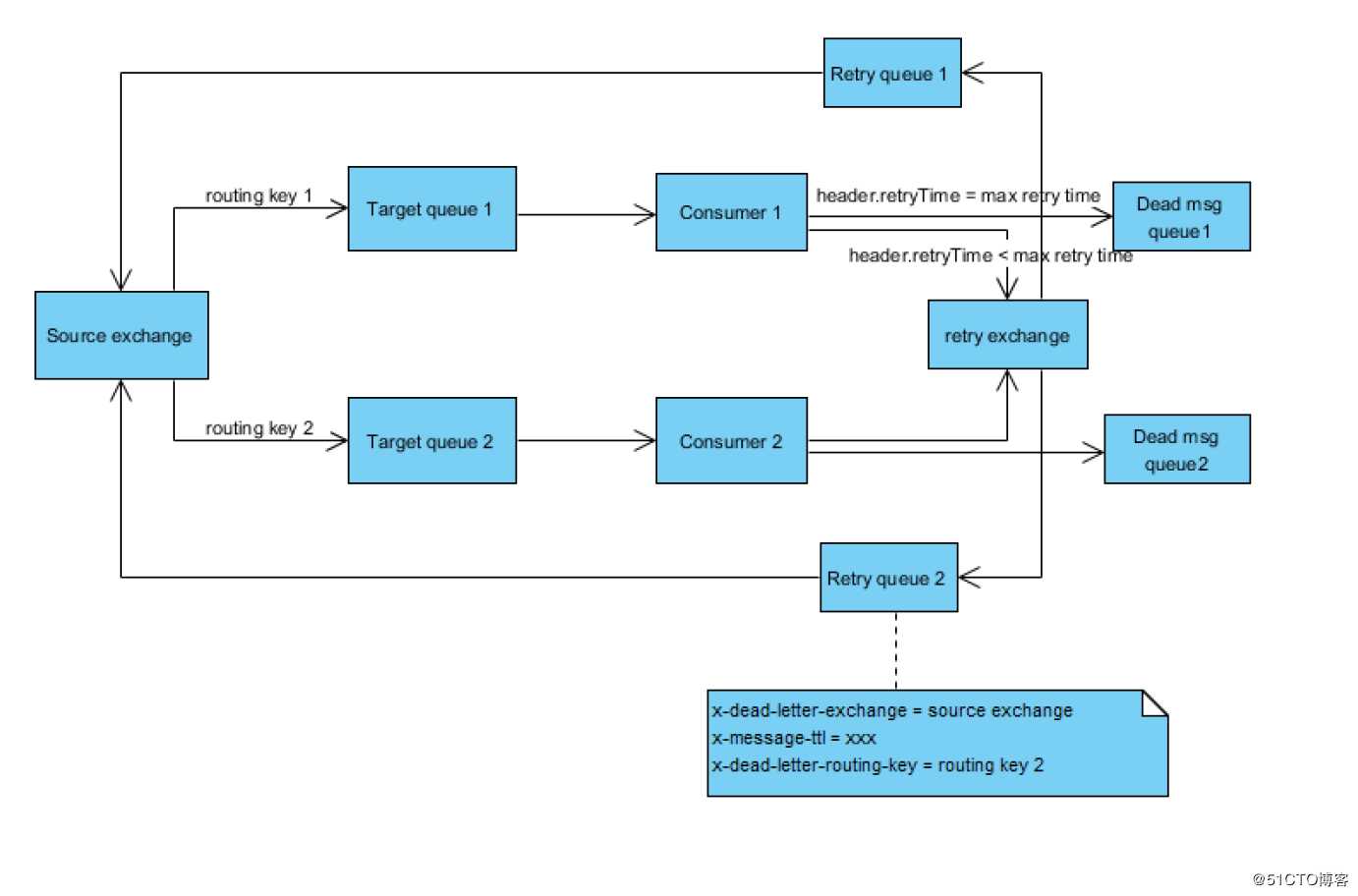标签:end tag OWIN null com ram callback factor war
Producer://enable publisher confirmation
channel.confirmSelect()
//register confirmation listener
channel.addConfirmListener(object: ConfirmListener {
override fun handleAck(deliveryTag: Long, multiple: Boolean) {
if (multiple) {
val headerMap = unackDataMap.headMap(deliveryTag)
headerMap.forEach { k, v ->
unackDataMap.remove(k)
callback(v)
}
}
else {
val dataToRemove = unackDataMap.remove(deliveryTag)
if (dataToRemove != null) {
callback(dataToRemove)
}
}
}
override fun handleNack(deliveryTag: Long, multiple: Boolean) {
}
})
//getting next sequence number
val deliverTag = channel.nextPublishSeqNo
//cache unacknowledged data
unackDataMap[deliverTag] = data
channel.basicPublish(exchange, routingKey, properties, body)Consumer:
There are serveral approaches to ensure reliable delivery:
// simple retrying with nack + requeue
channel.basicConsume(receiveQueueName, autoAck = false, object: DefaultConsumer(channel) {
try {
channel.basicAck(deliveryTag=tag, multiple=false)
}
catch (e: Exception) {
if (isRetriable(e)) {
channel.basicReject(deliveryTag=tag, requeue=true)
}
else {
//persist error payload
channel.basicReject(deliveryTag=tag, requeue=false)
}
}
})Use a separate deadletter exchange/queue for retrying. If deadletter exchange is specified for a queue, message will be put into it for the following cases:
For retry case, instead of calling basicReject with "requeue" = true, it will use option "requeue" = false and stop putting the message back to the original qeueue. It will send the message to a separate retry exchange and in turn routes to a retry queue. Three important attributes must be set on retry queue: x-dead-letter-routing-key. x-dead-letter-exchange and x-message-ttl. x-message-ttl. The retry queue has no consumer, message will stay in the queue up to x-message-ttl and expired. As explained above the expired with will be routed to its deadletter exchange specified by x-dead-letter-exchange, which is exactly the original exchange where producer sends data to. x-dead-letter-routing-key is set to the original routing key so that the message finally reaches the correct queue. A special message header "retryTimes" is used to control number of retries, each time a message is put back to retry queue, its retryTimes will be incremented by 1.
//retry configuration
fun createRetryQueue(
channel: Channel,
schemaName: String,
deadLetterRoutingKey: String,
retryExchangeName: String,
retryQueueName: String,
retryBindingName: String
) {
val queueAttributes = mutableMapOf("x-dead-letter-exchange" to EVENT_GLOBAL_EXCHANGE,
"x-message-ttl" to 20000,
"x-dead-letter-routing-key" to deadLetterRoutingKey
)
channel.exchangeDeclare(retryExchangeName, "topic")
channel.queueDeclare(retryQueueName, true, false, false, queueAttributes)
channel.queueBind(retryQueueName, retryExchangeName, retryBindingName)
}
val receiveQueueName = "tx.$schemaName.compliance.submit.queue"
val receiveBindingName = "*.compliance.submit.${schemaName.toUpperCase()}.#"
createRetryQueue(channel, schemaName, "global.compliance.submit.${schemaName.toUpperCase()}.queue", COMPLIANCE_INBOUND_RETRY_EXCHANGE,
"tx.$schemaName.complianceinbound.retry.queue", "*.tx.$schemaName.complianceinbound.retry.#")// retry code
val prevRetryTimes: Int = headers.let { it[RabbitMQSourceContext.ATTRIB_RETRYTIMES] as Int? } ?: 0
if (prevRetryTimes < rabbitMQSourceConfig.maxRetry) {
propMap[RabbitMQSourceContext.ATTRIB_RETRYTIMES] = prevRetryTimes + 1
val rabbitProps = BasicPropertyFactory.create(MessageProperties.PERSISTENT_TEXT_PLAIN, propMap)
channel.basicNack(deliveryTag, false, false)
logger.debug(
"Sending retry message, exchange={}, routingKey={}, properties={}, deliveryTag={}",
retryExchangeName, retryRoutingKey, propMap, deliveryTag
)
channel.basicPublish(retryExchangeName, retryRoutingKey, rabbitProps, payload)
} else {
logger.warn("Max retry time exceeded for queue={}, deliveryTag={}", rabbitMQSourceConfig.sourceQueueName, deliveryTag)
}
The major pro of this solution is that it supports delayed retry and message to retry will not block normal message processing
Cons of this solution is that it cannot really handle scenarios like exponential backoff. Because the TTL is a fixed value on a queue.
Leverage rabbitmq reliablity feature correctly
标签:end tag OWIN null com ram callback factor war
原文地址:https://blog.51cto.com/shadowisper/2428021